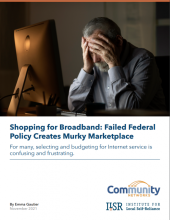Shopping for Broadband: Failed Federal Policy Creates Murky Marketplace

Report updated in January, 2022.
A new report from the Institute for Local Self-Reliance (ILSR) examines Internet Service Providers’ (ISPs) transparency — or lack thereof — around the Internet service packages they offer. Shopping for Broadband: Failed Federal Policy Creates Murky Marketplace [pdf] finds that locally-controlled broadband networks are the most transparent around key service details. Large ISPs, on the other hand, are more likely to make information like upload speed and pricing difficult or impossible to find.
Missing or unclear information is frustrating for anyone shopping for a new Internet service. It can make it especially difficult for low-income customers, who need to know pricing details (such as the difference between a service’s promotional price and standard monthly cost) in order to navigate the market and budget for service. Federal standards for transparency exist, but are not currently enforced in any real way by either federal regulation or market pressure.
Recently, Congress passed the Infrastructure Investment and Jobs Act, which includes new information disclosure requirements for ISPs. To underscore the value of these requirements and the need for their proper enforcement, this report offers detailed analysis of 50 of the nation’s largest private wireless, private fiber, cable, municipal, and cooperative ISPs based on how clearly they disclose basic service and pricing information. Key findings include:


